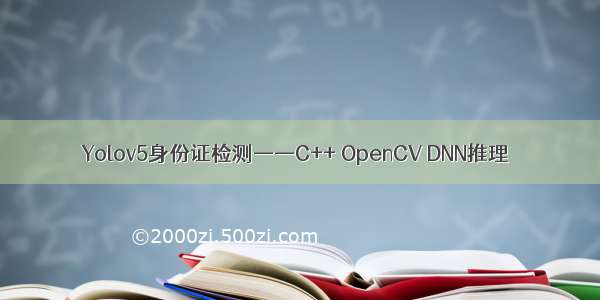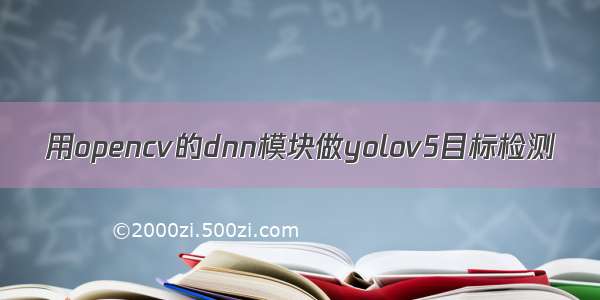
1.由于OpenCV DNN中的slice层不支持step为2,所以在转换模型时需要修改代码,修改的地方在models/common.py中Focus类
修改前:
class Focus(nn.Module):# Focus wh information into c-spacedef __init__(self, c1, c2, k=1, s=1, p=None, g=1, act=True): # ch_in, ch_out, kernel, stride, padding, groupssuper(Focus, self).__init__()self.conv = Conv(c1 * 4, c2, k, s, p, g, act)def forward(self, x): # x(b,c,w,h) -> y(b,4c,w/2,h/2)return self.conv(torch.cat([x[..., ::2, ::2], x[..., 1::2, ::2], x[..., ::2, 1::2], x[..., 1::2, 1::2]], 1))
修改后
class Focus(nn.Module):# Focus wh information into c-spacedef __init__(self, c1, c2, k=1, s=1, p=None, g=1, act=True): # ch_in, ch_out, kernel, stride, padding, groupssuper(Focus, self).__init__()self.conv = Conv(c1 * 4, c2, k, s, p, g, act)def forward(self, x): # x(b,c,w,h) -> y(b,4c,w/2,h/2)#return self.conv(torch.cat([x[..., ::2, ::2], x[..., 1::2, ::2], x[..., ::2, 1::2], x[..., 1::2, 1::2]], 1))return self.conv(x)
2.转换模型
python models/export.py --weights runs/exp/weights/best.pt# --weights: 训练得到的模型
运行后,onnx模型保存为了runs/exp/weights/best.onnx,这个模型就可以用OpenCV DNN进行推理。
3.DNN C++推理
#include <iostream>#include <string>#include <vector>#include <fstream>#include <sstream>#include <opencv2/opencv.hpp>#include <opencv2/dnn.hpp>void imshow(std::string name, const cv::Mat& cv_src) {cv::namedWindow(name, 0);int max_rows = 800;int max_cols = 800;if (cv_src.rows >= cv_src.cols && cv_src.rows > max_rows){cv::resizeWindow(name, cv::Size(cv_src.cols * max_rows / cv_src.rows, max_rows));}else if (cv_src.cols >= cv_src.rows && cv_src.cols > max_cols){cv::resizeWindow(name, cv::Size(max_cols, cv_src.rows * max_cols / cv_src.cols));}cv::imshow(name, cv_src);}inline float sigmoid(float x){return 1.f / (1.f + exp(-x));}void sliceAndConcat(cv::Mat& img, cv::Mat* input){const float* srcData = img.ptr<float>();float* dstData = input->ptr<float>();using Vec12f = cv::Vec<float, 12>;for (int i = 0; i < input->size[2]; i++){for (int j = 0; j < input->size[3]; j++){for (int k = 0; k < 3; ++k){dstData[k * input->size[2] * input->size[3] + i * input->size[3] + j] =srcData[k * img.size[2] * img.size[3] + 2 * i * img.size[3] + 2 * j];}for (int k = 0; k < 3; ++k){dstData[(3 + k) * input->size[2] * input->size[3] + i * input->size[3] + j] =srcData[k * img.size[2] * img.size[3] + (2 * i + 1) * img.size[3] + 2 * j];}for (int k = 0; k < 3; ++k) {dstData[(6 + k) * input->size[2] * input->size[3] + i * input->size[3] + j] =srcData[k * img.size[2] * img.size[3] + 2 * i * img.size[3] + 2 * j + 1];}for (int k = 0; k < 3; ++k){dstData[(9 + k) * input->size[2] * input->size[3] + i * input->size[3] + j] =srcData[k * img.size[2] * img.size[3] + (2 * i + 1) * img.size[3] + 2 * j + 1];}}}}std::vector<cv::String> getOutputNames(const cv::dnn::Net& net){static std::vector<cv::String> names;if (names.empty()){std::vector<int> outLayers = net.getUnconnectedOutLayers();std::vector<cv::String> layersNames = net.getLayerNames();names.resize(outLayers.size());for (size_t i = 0; i < outLayers.size(); i++){names[i] = layersNames[outLayers[i] - 1];}}return names;}void drawPred(int classId, float conf, int left, int top, int right, int bottom, cv::Mat& frame,const std::vector<std::string> &classes){cv::rectangle(frame, cv::Point(left, top), cv::Point(right, bottom), cv::Scalar(0, 255, 0), 3);std::string label = cv::format("%.2f", conf);if (!classes.empty()) {CV_Assert(classId < (int)classes.size());label = classes[classId] + ": " + label;}int baseLine;cv::Size labelSize = cv::getTextSize(label, cv::FONT_HERSHEY_SIMPLEX, 0.5, 1, &baseLine);top = std::max(top, labelSize.height);cv::rectangle(frame, cv::Point(left, top - round(1.5 * labelSize.height)), cv::Point(left + round(1.5 * labelSize.width), top + baseLine), cv::Scalar(0, 255, 0), cv::FILLED);cv::putText(frame, label, cv::Point(left, top), cv::FONT_HERSHEY_SIMPLEX, 0.75, cv::Scalar(), 2);}void postprocess(cv::Mat& cv_src, std::vector<cv::Mat>& outs, const std::vector<std::string>& classes, int net_size) {float confThreshold = 0.4f;float nmsThreshold = 0.5f;std::vector<int> classIds;std::vector<float> confidences;std::vector<cv::Rect> boxes;int strides[] = {8, 16, 32 };std::vector<std::vector<int> > anchors = {{10,13, 16,30, 33,23 },{30,61, 62,45, 59,119 },{116,90, 156,198, 373,326 }};for (size_t k = 0; k < outs.size(); k++){float* data = outs[k].ptr<float>();int stride = strides[k];int num_classes = outs[k].size[4] - 5;for (int i = 0; i < outs[k].size[2]; i++){for (int j = 0; j < outs[k].size[3]; j++){for (int a = 0; a < outs[k].size[1]; ++a){float* record = data + a * outs[k].size[2] * outs[k].size[3] * outs[k].size[4] +i * outs[k].size[3] * outs[k].size[4] + j * outs[k].size[4];float* cls_ptr = record + 5;for (int cls = 0; cls < num_classes; cls++) {float score = sigmoid(cls_ptr[cls]) * sigmoid(record[4]);if (score > confThreshold){float cx = (sigmoid(record[0]) * 2.f - 0.5f + (float)j) * (float)stride;float cy = (sigmoid(record[1]) * 2.f - 0.5f + (float)i) * (float)stride;float w = pow(sigmoid(record[2]) * 2.f, 2) * anchors[k][2 * a];float h = pow(sigmoid(record[3]) * 2.f, 2) * anchors[k][2 * a + 1];float x1 = std::max(0, std::min(cv_src.cols, int((cx - w / 2.f) * (float)cv_src.cols / (float)net_size)));float y1 = std::max(0, std::min(cv_src.rows, int((cy - h / 2.f) * (float)cv_src.rows / (float)net_size)));float x2 = std::max(0, std::min(cv_src.cols, int((cx + w / 2.f) * (float)cv_src.cols / (float)net_size)));float y2 = std::max(0, std::min(cv_src.rows, int((cy + h / 2.f) * (float)cv_src.rows / (float)net_size)));classIds.push_back(cls);confidences.push_back(score);boxes.push_back(cv::Rect(cv::Point(x1, y1), cv::Point(x2, y2)));}}}}}}std::vector<int> indices;cv::dnn::NMSBoxes(boxes, confidences, confThreshold, nmsThreshold, indices);for (size_t i = 0; i < indices.size(); i++) {int idx = indices[i];cv::Rect box = boxes[idx];drawPred(classIds[idx], confidences[idx], box.x, box.y,box.x + box.width, box.y + box.height, cv_src, classes);}}int main(int argc, char* argv[]){std::string path = "images";std::vector<std::string> filenames;cv::glob(path, filenames, false);for (auto name : filenames){cv::Mat cv_src = cv::imread(name);if (cv_src.empty()){continue;}std::vector<std::string> class_names{"ida","idb" };int net_size = 640;cv::Mat blob = cv::dnn::blobFromImage(cv_src, 1.0 / 255, cv::Size(net_size, net_size),cv::Scalar(0, 0, 0), true, false);cv::dnn::Net net = cv::dnn::readNet("model/ODID_DNN.onnx");const int sz[] = {1, 12, net_size / 2, net_size / 2 };cv::Mat input = cv::Mat(4, sz, blob.type());sliceAndConcat(blob, &input);net.setInput(input);auto t0 = cv::getTickCount();std::vector<cv::Mat> outs;net.forward(outs, getOutputNames(net));postprocess(cv_src, outs, class_names, net_size);auto t1 = cv::getTickCount();std::cout << "elapsed time: " << (t1 - t0) * 1000.0 / cv::getTickFrequency() << "ms" << std::endl;imshow("img", cv_src);cv::waitKey();}return 0;}
检测一张图像大概要0.1秒左右。
4.模型和源码以上传CSDN。地址:/download/matt45m/46982918
















